STE Highlights, January 2022
Computer, Computational and Statistical Sciences
Hybrid, scalable, trace-driven performance modeling of GPGPUs
Materials Physics and Applications
Quantum light source offers new possibilities for communications and computing
Chemistry
Alkali metal alkoxides in Noyori-type hydrogenations
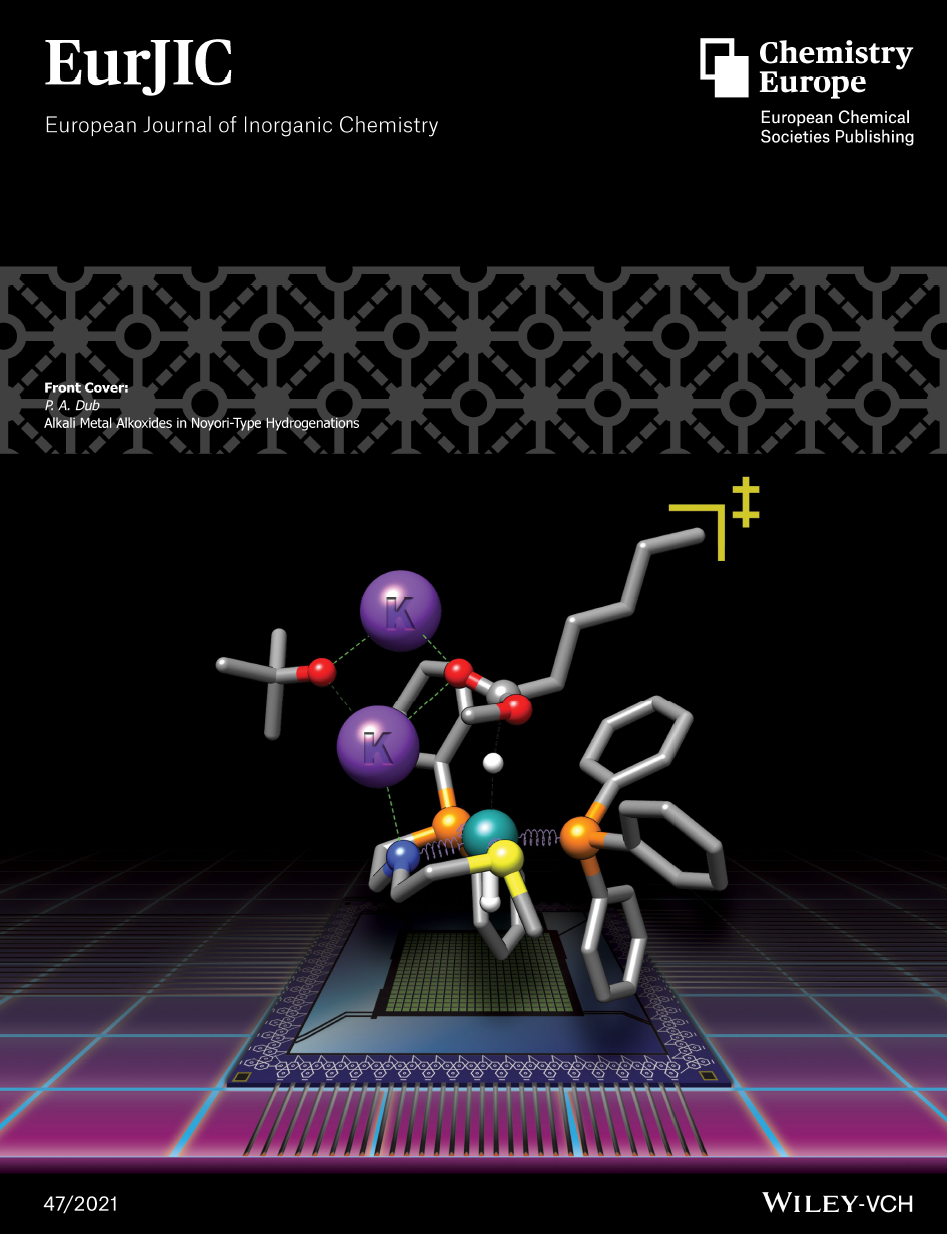
The graphic on the front cover of EurJIC shows a density-functional-theory-optimized transition state structure corresponding to the outer-sphere hydride transfer realized in the Noyori-type potassium amidate complex. One explicit (CH3)3COK molecule stabilizes the transition state through noncovalent interactions with both catalyst and substrate. Non-critical hydrogen atoms are omitted for clarity.
Ketones and esters are ubiquitous fossil and biorenewable feedstocks – materials that can be converted to fuels. Their catalytic reduction with molecular hydrogen (H2) is an efficient pathway to alcohols, which are valuable fuels, solvents and building blocks for organic synthesis. In a recent review article featured on the cover of the European Journal of Chemistry, Pavel Dub of the Inorganic, Isotope, and Actinide Chemistry group (C-IIAC) gave an overview of how alkali metal alkoxides accelerate the transformation of esters and ketones into alcohols with Noyori-type molecular catalysts.
Ryoji Noyori won the Nobel Prize in Chemistry for contributions to the asymmetric hydrogenation of ketones. Noyori-type catalysts are bifunctional, meaning that both the metal and ligand are functional. The catalysts have wide applicability in industry and research. The use of soluble molecular catalysts in hydrogenations allows highly selective transformations, leading to useful products for the fine chemical industry and related enterprises.
The review article summarizes the current state of research around these vitally important catalysts. The high activity and selectivity of Noyori-type catalysts is due to an N‒H functionality coordinated to the metal and capable of establishing non-covalent interaction with a substrate within the catalyst-substrate complex. Specifically, the ligand facilitates bond cleavage/formation events occurring in the catalyst outer-sphere through the stabilization of the “determining” transition states via hydrogen-bonding interactions. The detailed mechanisms pertaining to ketone and ester as catalysts are still not fully understood, presenting many possibilities for further investigation.
Funding and Mission
This work was funded by Laboratory Directed Research and Development, in support of the Global Security mission area and the Materials for the Future capability pillar.
Reference
“Alkali metal alkoxides in Noyori-type hydrogenations,” European Journal of Inorganic Chemistry, 2021, 47, 4882 (2021). DOI: https://doi.org/10.1002/ejic.202100742. Author: Pavel Dub (C-IIAC).
Technical Contact: Pavel Dub
Computer, Computational and Statistical Sciences
Hybrid, scalable, trace-driven performance modeling of GPGPUs
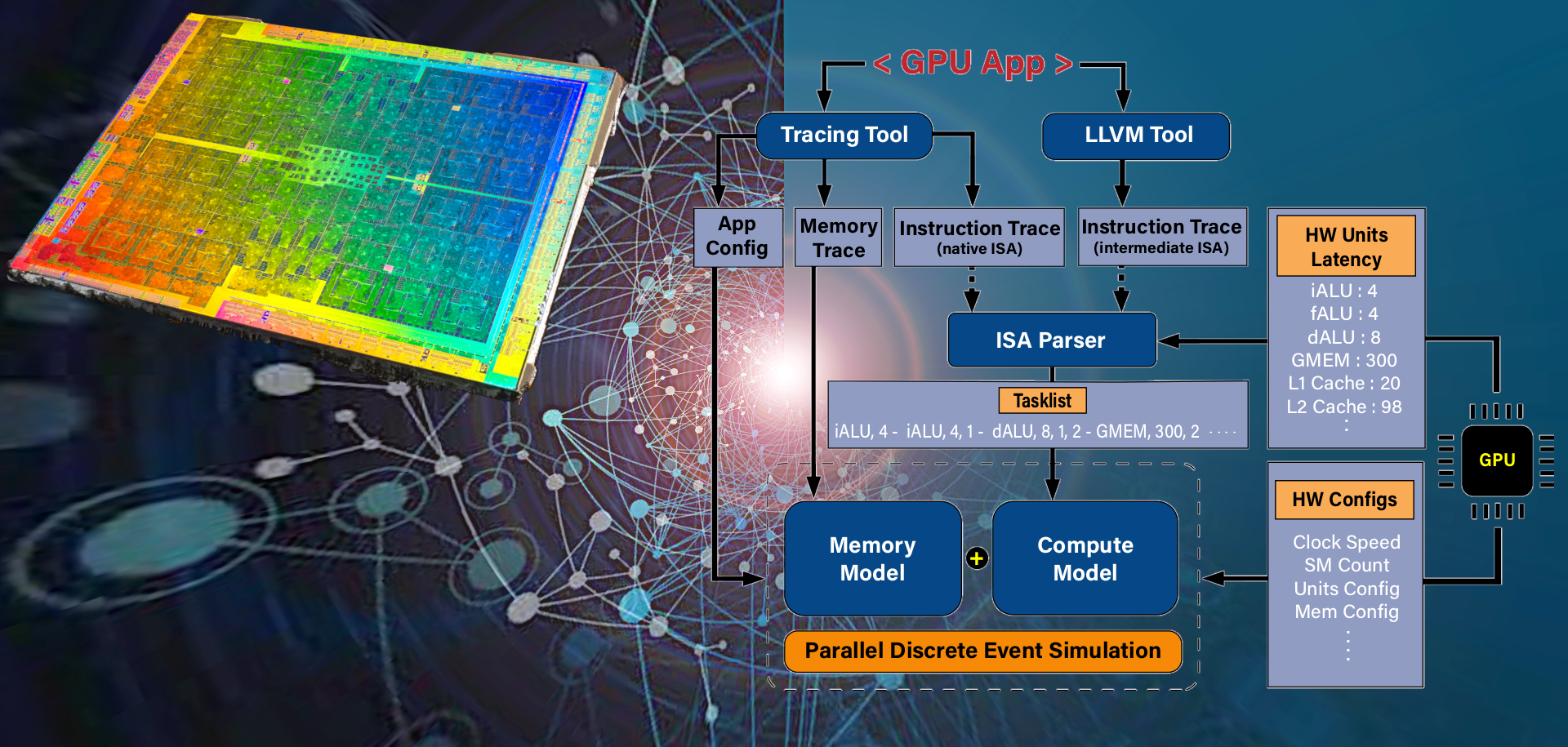
A block diagram of the PPT-GPU toolkit flow used to simulate the performance of a GPU application is shown in the figure A typical neural network graph and GPU chip are in the background.
Researchers in Los Alamos National Laboratory’s Information Sciences group (CCS-3) have collaborated with colleagues from New Mexico State University on a new toolkit for graphics processing units (GPUs), innovation described in SC ’21: Proceedings of the International Conference for High Performance Computing, Networking, Storage and Analysis. The PPT-GPU is a scalable performance prediction toolkit for GPUs. A hybrid, high-level modeling approach that can extrapolate some computations and parallelize multiple parts of a model provides the PPT-GPU scalability and means the PPT-GPU is up to three orders of magnitude faster over alternative, cycle- accurate performance simulator tools, with almost no penalty in predication accuracy.
The toolkit allows high-performance computing (HPC) programmers to predict the runtime performance of the GPU kernels of their codes. The ability to predict runtime performance before undertaking time-intense code refactoring improves efficiency. The cycle-accurate performance simulators used in contemporary research are typically very slow; the PPT-GPU toolkit overcomes that bottleneck by using a hybrid, parallel discrete event simulation for instruction-level modeling and probabilistic modeling for memory access. Science applications that previously took weeks to simulate and analyze may take just hours, speeding up the software-hardware codesign process considerably. In addition to gains in speed, the researchers achieved results in accuracy with performance predications highly correlated to the actual hardware: a mean average percentage error of less than 16%, and a correlation of greater than 0.98.
GPUs have a role in scientific computation applications such as machine learning, drug discovery and more. The PPT-GPU toolkit is a building block for allowing a fast transition of computational physics codes to GPU and similar novel computer architecture platforms. The toolkit’s development tracks with significant efforts at the Laboratory and in the entire Department of Energy complex to efficiently leverage GPU architectures. The formidable algorithmic and software engineering challenge is necessary because currently six out of the top 10 supercomputers in the world (according to the industry publication TOP500) feature GPUs to achieve peak performance. The ability to accurately and scalably model and simulate the performance of large science codes on existing and proposed new GPU chips stands to improve code performance. In turn, such advances help researchers tackle even harder computational problems, from artificial intelligence to pandemic response.
Currently led by Nandakishore Santhi of CCS-3, the PPT-GPU toolkit project is the product of a long-standing collaboration between the Laboratory’s Computer, Computational and Computer Sciences division, its HPC division, and New Mexico State University. The collaboration is centered around two to three graduate students who spend time at Laboratory, in person or virtually, and have chosen dissertation topics relevant to the Laboratory’s Information Science and Technology capability. Frequent visits by collaborating NMSU professors also helps leverage academic resources and capabilities from within New Mexico.
Reference
“Hybrid, scalable, trace-driven performance modeling of GPGPUs,” SC '21: Proceedings of the International Conference for High Performance Computing, Networking, Storage and Analysis, 53, 1-15 (2021). DOI: https://doi.org/10.1145/3458817.3476221 Authors: Yehia Arafa, Abdel-Hameed Badawy, Ammar ElWazir, Atanu Barai, Ali Eker, Gopinath Chennupati, Nandakishore Santhi, Stephan Eidenbenz.
Mission and Funding
The work is supported by the Advanced Simulation and Computing program by the NNSA and augments the Laboratory’s Global Security mission area and its Information Science and Technology capability pillar.
Technical Contacts: Nandakishore Santhi and Stephan Eidenbenz
Materials Physics and Applications
Quantum light source offers new possibilities for communications and computing
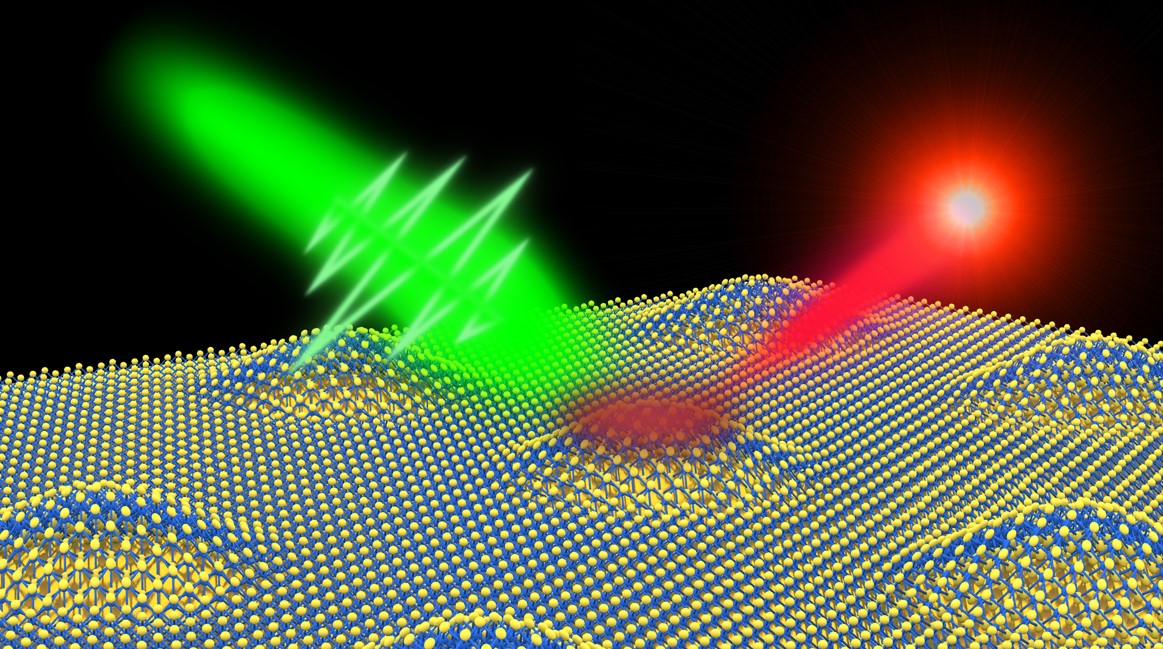
Pictured is an atomically-thin MoTe2 layer (blue and yellow lattice) on strain-inducing nanopillars as site-controlled telecom-wavelength quantum emitters for coupling to optical fibers with minimal loss. Single photons (red) are generated upon optical excitation (green).
A quantum light source recently developed by researchers at the Center for Integrated Nanotechnologies (CINT) presents new capabilities for quantum communication and computing. As described recently in Nature Communications, the technological advancement enables the integration of two-dimensional material-based quantum light sources into existing fiber optic communication networks for practical implementation of quantum cryptography and metrology applications. Light sources may also play a role in quantum computing networks.
Conventional light sources emit many photons simultaneously. Lasers also emit photons simultaneously, though they do so in a single color (wavelength) and in one direction. In today’s fiber optic communication networks, laser light pulses, each containing millions of photons, are used to encode the information being transmitted. As a result, information can easily be stolen by splitting some photons of the light pulses.
In quantum communication, however, information is encoded in the phase of a single photon, making information impossible to steal. This new communication scheme requires light sources capable of emitting a stream of single photons at regular intervals. A “quantum” light source cannot be created by simply dimming the conventional light sources and lasers – no matter how much one dims such light sources, the probability of two photons emitted at the same time is always finite. Quantum light sources should also produce photons at the wavelength compatible with existing fiber communication networks (i.e., 1.35 or 1.55 microns).
The CINT research team recently realized a quantum light source with operating wavelength tunable across O and C telecommunication bands by placing atomically thin molybdenum ditelluride (MoTe2) semiconductor layers on top of an array of strain-inducing nanometer-sized pillars. Hanbury Brown and Twiss experiments conducted at 10 K reveal clear photon antibunching with 90% single-photon purity. The photon antibunching can be observed up to liquid nitrogen temperature (77 K). Because the pillars can be fabricated via electron beam lithography, the quantum light sources can be placed to a desired location with nanometer precision.
In addition to quantum communication applications, facile layer-by-layer device fabrication allowed by the two-dimensional nature of the MoTe2 provides an opportunity to integrate these light sources into emerging quantum computers as a key element for forming a quantum network. Because a stream of single photons can have intensity fluctuations smaller than the fundamental fluctuation limit possible for a laser light (i.e., shot-noise limit), fiber-coupled quantum light sources can also enable ultra-sensitive absorption/reflection measurements for chemo/bio sensing applications.
Mission and Funding
This work was supported by the U.S. Department of Energy (DOE) Office of Science, the Office of Science Basic Energy Sciences program, the Laboratory Directed Research and Development program, the Quantum Science Center, and from a Laboratory Director’s Postdoc Fellow Award. The work supports the Global Security mission area and the Materials for the Future capability pillar.
Reference
“Site-Controlled Telecom-Wavelength Single-Photon Emitters in Atomically-thin MoTe2,” Nature Communications, 12, 6753 (2021); DOI: https://doi.org/10.1038/s41467-021-27033-w. Authors: Huan Zhao, Michael T. Pettes, Yu Zheng and Han Htoon.
Technical Contact: Han Htoon
Observing magnetoelastic standing waves in uranium dioxide
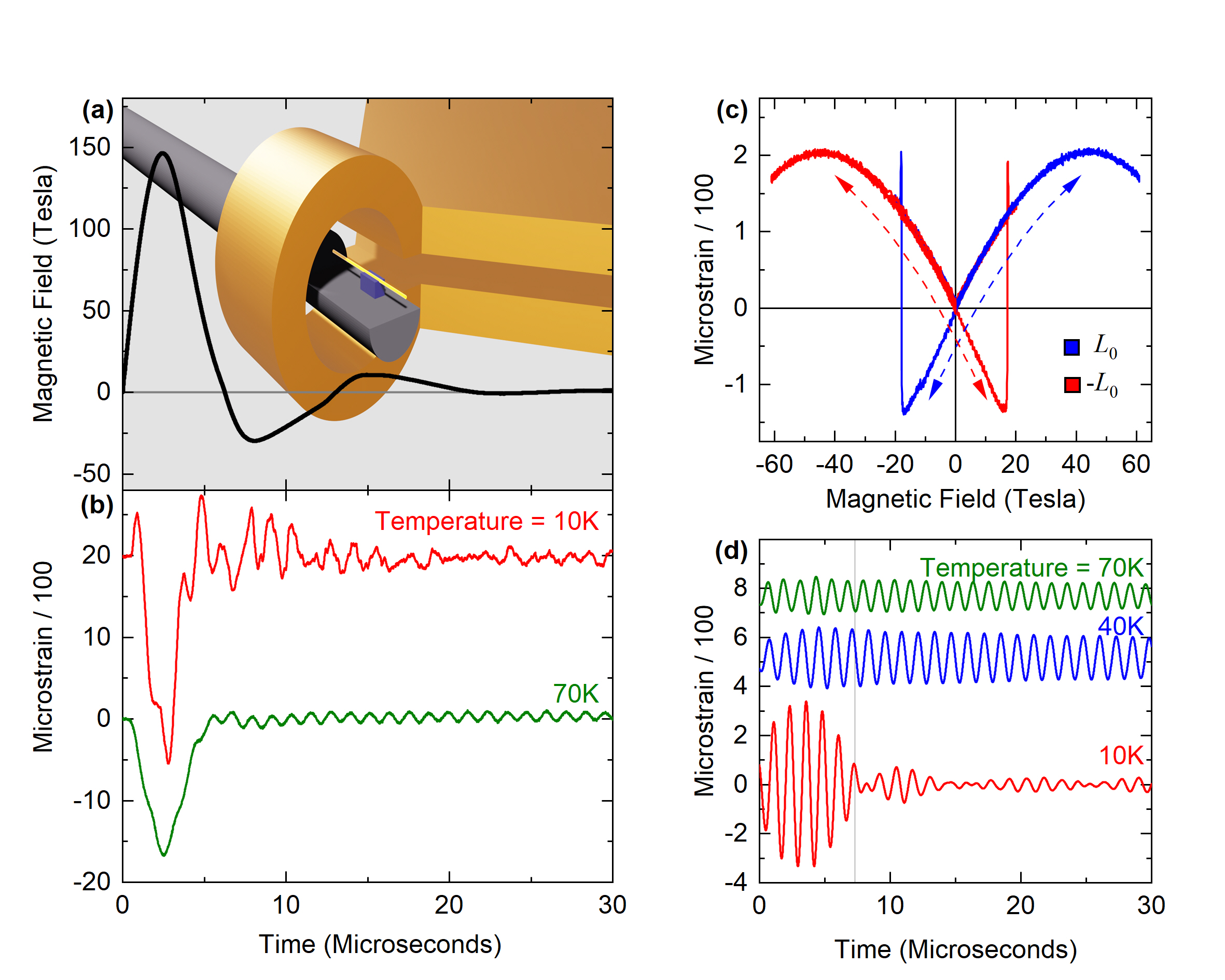
The figure shows (a) magnetic field pulse profile with a sketch of the single-turn coil and the sample attached to the Fiber Bragg Grating in the background; (b) magnetostriction signal vs. time; (c) piezomagnetic butterfly of UO2 in pulsed magnetic fields; and (d) 800 kHz resonance at different temperatures with the lowest temperature curve showing pronounced attenuation at the piezomagnetic switching field of -20T (at around 7 microseconds).
Uranium dioxide (UO2) is the most important nuclear fuel in commercial power reactors. In fact, about 20% of the energy generated in the United States comes from UO2. But a full understanding of the material’s thermal characteristics, entirely given by its elastic properties, is still incomplete. Los Alamos National Laboratory researchers recently contributed to the first observation of phase and amplitude of magnetoelastic standing waves in UO2 persisting from cryogenic to room temperatures. They found the standing waves being modulated by a piezomagnetic switching behavior, which results in a phase shift and attenuation of the dominating resonance frequency within the antiferromagnetic state below 30 Kelvin. The research was described in the Proceedings of the National Academy of Sciences.
The observed interconnections between magnetic and elastic properties of UO2, a poor thermal conductor, contribute to a better understanding of the material’s thermal characteristics, a view that can impact its efficiency as a nuclear fuel. Indeed, strong attenuation of elastic waves can be seen as thermal transport losses driven by the microscopic piezomagnetism of the material. (Piezomagnetism is characterized by the induction of a magnetic polarization by application of mechanical strain, and vice versa.) The magnetic dynamics in UO2 are typically hard to detect, but the modulation of the piezomagnetic switching behavior offers a sensitive probe for those properties.
The experiments show for the first time that mechanical lattice vibrations can be induced in a magnetic material in the bulk by means of magnetic field pulses, without the need for a piezoelectric transducer (a device to convert electric energy into mechanical stress) or other intermediary mechanism. The research team also presented a theoretical model to explain the observations, arguing that the unexpected behavior results from the reversal of the antiferromagnetic order parameter at Hc, or coercive field strength. Coercive field strength is the force at which a material is demagnetized.
The team’s findings offer a way to study magnetic dynamics in high magnetic fields. For experiments involving semidestructive pulsed magnetic fields, the findings may help interpret past and future data. In addition, the findings may offer practical implications – for example, as a way to trigger resonators at faster speeds.
Mission and Funding
This work was supported by The National High Magnetic Field Laboratory, which is supported by the National Science Foundation and the state of Florida; the Laboratory Directed Research and Development (LDRD) at Los Alamos National Laboratory; the G. T. Seaborg Institute; the NHMFL User Collaboration Grants Program; the Army Research Office; the Vannevar Bush Faculty Fellowship; the U.S. Department of Energy (DOE) Early Career Research Program and DOE Basic Energy Science (BES) Energy Frontier Research Center “Thermal Energy Transport under Irradiation”; the DOE BES program through the project “Science at 100T” at LANL; and the Institute for Materials Science at Los Alamos National Laboratory. The work supports the Global Security mission area and the Nuclear and Particle Futures capability pillar.
Reference
“Magnetoelastic standing waves induced in UO2 by microsecond magnetic field pulses,” Proceedings of the National Academy of Sciences, 118, 51, e2110555118 (2021). DOI: https://doi.org/10.1073/pnas.2110555118. Authors: Rico Schönemann (MPA-MAGLAB), Dwight Rickel, Fedor Balakirev, Ross D. McDonald, Boris Maiorov, Andreas V. Stier, Myron B. Salamon, Marcelo Jaime (MPA-MAGLAB); George Rodriguez (Q-6); Jordan A. Evans, Krzysztof Gofryk (Idaho National Laboratory; Charles Paillard (University of Paris-Saclay); Laurent Bellaiche (University of Arkansas).
Technical Contact: Rico Schönemann and Marcelo Jaime
Physics
Electron vacuum laser acceleration using relativistic transparency injection
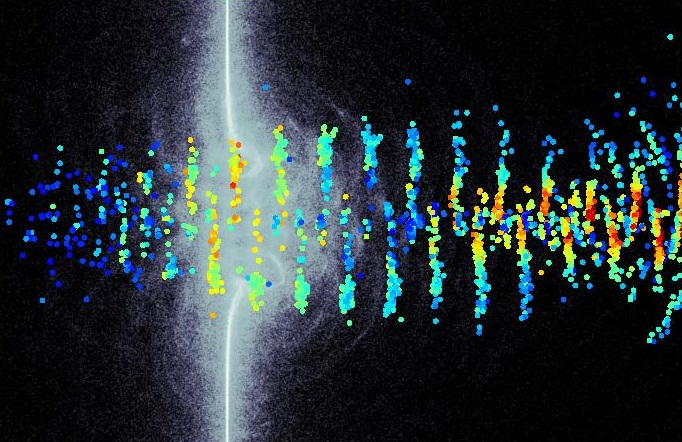
An MeV electron beam is shown driven out of the plasma. The laser beam is incident on the plasma from the left.
X-ray radiography is widely used in weapons community research. However, given the performance limits and constrainst of existing technology, there is a growing need for compact, MeV (high-energy) x-ray sources of intermediate dose levels. Novel x-ray sources based on high-power short-pulse lasers offer unique advantages for new x-ray radiography, but generating the source depends on the efficient conversion of laser energy into the MeV electron beam – a challenge addressed recently by a team of researchers, including members of the Physics division at Los Alamos National Laboratory.
Exploiting a unique plasma property known as relativistic transparency, researchers at Los Alamos National Laboratory have devised an innovative way to use vacuum laser acceleration (VLA) to pre-accelerate plasma electrons to light speed. The pre-acceleration allows the plasma electrons to be accelerated subsequent to joining the laser wave. The breakthrough was described in a recent publication of Nature Communications.
Intense lasers can accelerate electrons in a dense plasma to near-light speed almost instantaneously, generating a multi-MeV electron beam. When such an electron beam travels through a millimeter thick tantalum slab, it generates a large amount of MeV x-ray photons via bremsstrahlung radiation, which is used to radiograph dense objects. Making an efficient laser-driven MeV x-ray source almost entirely depends on the efficient conversion of incident laser energy into the MeV electron beam in the first place.
The VLA technique for driving an electron beam out of a plasma, in which the laser directly accelerates electrons to high energy, means electrons ride the laser light wave and gain energy – like a surfer riding a wave and gaining speed. Despite the simplicity, the technique is hard to achieve in practice because for an electron to catch the laser light wave it needs to be traveling close to light speed in the first place, unlike a surfer catching a wave. This constraint requires the electrons to be pre-accelerated to near the speed of light so that they can catch the laser wave and ride it.
Free-electron injection, and subsequent vacuum laser acceleration of electrons up to 20 MeV, relies on use of the relativistic transparency effect. When a high-contrast intense laser drives a thin solid foil, electrons from the dense opaque plasma are first accelerated to near-light speed by the standing laser wave in front of the solid foil and subsequently injected into the transmitted laser field as the opaque plasma becomes relativistically transparent. Dense plasmas normally block the incident laser light and do not allow them to transmit through by rearranging the plasma electrons quickly. However, as the electrons start to drift in the laser field and gain energy, they become heavier due to relativistic effects and cannot block the incident laser quickly enough. This allows the laser to penetrate through the dense plasma. As the laser penetrates through the dense plasma, the electrons that have been accelerated to near light speed due to the drift force can now catch the laser wave and gain more energy by riding the wave.
Novel x-ray sources based on high-power short-pulse lasers offer unique advantages such as small spot size, flexible configuration, and tailorable spectra. Those advantages will allow researchers to deploy flexible, compact x-ray sources for static tomographic radiography and dynamic multi-axis radiography at Laboratory firing sites and at facilities such as Proton Radiography (pRad) and the U1a Complex at the Nevada National Security Site.
The higher resolution, shorter pulse duration, and tunability of these sources will help in the further development of laser-driven compact x-ray sources for radiography and enable new applications in the weapons program and broader scientific community.
Funding and Mission
The research was supported by the Laboratory Directed Research and Development (LDRD) Program of Los Alamos National Laboratory (LANL).This research used resources provided by the Los Alamos National Laboratory Institutional Computing Program, which is supported by the U.S. Department of Energy National Nuclear Security Administration. The experiments were conducted at the CSU ALEPH laser facility supported by the U.S. Department of Energy LaserNetUS. CSU researchers acknowledge the support of the Air Force Office of Scientific Research. The research supports the Global Security mission area and the Nuclear and Particle Futures capability pillar.
Reference
“Vacuum laser acceleration of super-ponderomotive electrons using relativistic transparency injection,” Nature Communications, 13, 54 (2022). DOI: https://doi.org/10.1038/s41467-021-27691-w. Authors: P. K. Singh, F.-Y. Li, C.-K., A. Junghans, A. Favalli, B. Reinovsky, S. Palaniyappan (Los Alamos National Laboratory); A. Moreau, R. Hollinger, S. Wang, Y. Wang, H. Song, C. Calvi and J. J. Rocca (Colorado State University).
Technical Contact: Sasikumar Palaniyappan





